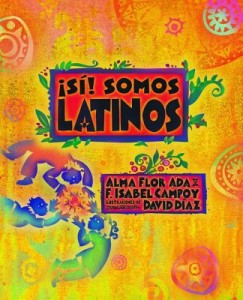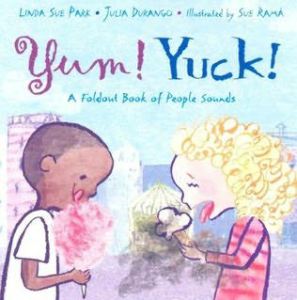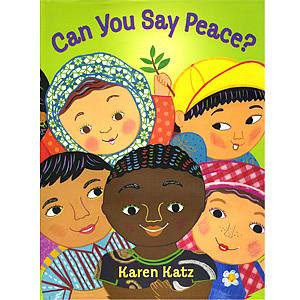It’s October already and this month the ReaderKidZ will be sharing books about our natural world. We’re kicking it off with the gorgeous and informative, STAR STUFF: Carl Sagan and the Mysteries of the Cosmos (Roaring Brook Press, 2014), which hits bookstore shelves October 14th. Coming up on Friday, Stephanie Greene shares an interview with STAR STUFF author/illustrator, Stephanie Roth Sisson. In the meantime, whet your appetite by taking a peek at this review from TTPM:
Mix It Up!
In previous posts, we’ve recommended two of Hervé Tullet‘s books – PRESS HERE and DOODLE COOK, both of which inspire readers to enjoy the magic of color, shape, and imagination. Tullet’s newest, MIX IT UP, (Chronicle Books, 2014) introduces young learners to primary and secondary colors, color mixing, tints, tones, and shades and makes an excellent addition to a young child’s library or a primary classroom teacher’s resources.
From the flap copy: “Watch colors splatter, mix, and transform, all at the touch of a finger. Follow the directions and turn the page: Magic and fun await!” Kids will enjoy the interactive, “mixing it up” format, and parents and teachers will love that the “hands-on” fun is of the no-fuss, no-muss variety.
COLORS OF THE WIND
COLORS OF THE WIND is a picture-book biography with startling paintings that open your eyes, and also a true story about an Olympic champion runner and award-winning artist who is blind: George Mendoza. The author, J.L. Powers, tells us:
“To me, it’s an amazing story of someone who has persisted and found such an incredible gift in his weakness. He broke a world record as a blind runner and went to the Olympics twice, and later started painting these bold paintings that he cannot see….”
COLORS OF THE WIND is illustrated with Mendoza’s paintings as well as simple line drawings by Hayley Morgan-Saunders. Besides being a champion athlete and artist, Mendoza is also the founder of Wise Tree Foundation, a nonprofit corporation that promotes the arts. A collection of Mendoza’s colorful and unusual paintings is a National Smithsonian Affiliates traveling exhibition.
Mendoza, a Las Cruces native, started going blind at age 15 from a degenerative eye disease. He often describes his condition as “kaleidoscope eyes,” losing his central vision but seeing things that were not there, extraordinary colors or objects multiplied and reflected back. But as a child, George did not want to be an artist or runner; he wanted to be a basketball player. He was good, until as a teen-ager, he “tried shooting baskets, but he kept missing. Instead of a basket, he saw an enormous eye floating in the air.”
As George lost more of his sight, he became discouraged. “Whenever he tripped over something that everybody else could see, he yelled at himself. When a priest suggested, “Nobody else sees the way you do…You should paint what you see.” But George did not want to paint. He wanted to be a basketball star. He thought, “I’ll never be able to do what everybody else can do.”
That’s when George started to run. Even blind, he could run faster than almost everyone. George discovered that “everybody was good at something.”
George faced his blindness and discovered amazing gifts; one was a unique and different imagination – a different way of seeing the world. He thought about the little girl, blind from birth, who asked, “What color is the wind?” and the blind singer who described his backyard tree as reaching up into the sky more than 35 miles. A tree more than 35 miles tall? Who would imagine such a thing!
Kathi Appelt, author of “The True Blue Scouts,” “Sugar Man” and “The Underneath,” describes the book as “an illumination of the persistent power of art.” The book “reminds us all that our biggest burdens are often our greatest gifts.”
COLORS OF THE WIND is a gift to give yourself and to share with readers of all ages. And imagine … what colors would you paint the wind?
Published 2014 by Purple House Press. Leave a comment and enter your name in our drawing for a complimentary copy.
Unexpected Friendships
A dutiful farmer toils away at daily chores. In the distance, a circus train crosses the barren countryside. As the farmer looks on, a small passenger flips and spills, unhurt, onto the soft ground. As the farmer approaches, a baby clown with a tall red cap, white face, and painted-on smile greets him. The young clown leaps and runs into the farmer’s arms and so begins this marvelous and tender story of unexpected friendship. The Farmer and the Clown by Marla Frazee – a story about the power of the unexpected, and the joy of friendship.
For more, check out Marla’s terrific interview with Roger Sutton, Editor and Chief of The Horn Book. And you won’t want to miss this sampling of the book on the publisher’s site.
YES! WE ARE LATINOS
By Alma Flor Ada and F. Isabel Campoy, pictures by David Diaz
Voices! The power and pride singing throughout this book is felt in each of the thirteen distinctive narrative poems. Each poem is told in the first-person voice of a Latino child who introduces his or her unique cultural background and situation. Personalities shine. Individuals become real. Stories touch your heart. Each poem is followed by a few pages of informative nonfiction that outlines related aspects of the child’s history and culture. What a rich and diverse bouquet of celebration!
READERS of all ages, this is a stunning book that crumbles stereotypes. For a chance to receive a complimentary copy, leave a comment and we will draw names from our “book hat.”
May I introduce Juanita who says:
“I am Mexican, I live in New York. I am Latina.”
But unknown to her teacher, her home language is not Spanish, but Mixtec, a “secret language that no one in this school even suspects exists.”
And then a surprise arrives at Juanita’s classroom – a new student, Elena….
“Next to the teacher stands a girl –
her skin the same rich color as mine,
her hair, black, long, and as straight as mine, and
her face showing the same surprise as mine —
a surprise that makes her dark eyes sparkle
like black obsidian in the sun….”
Meet for a moment, Rocio, whose grandparents were refugees from Spain during the terrible times when General Franco was the dictator. Rocio shares lines from her grandparent’s diary and then her impressions when —
“A year ago I went with Abu Amaya to see Guernica –
the town…that inspired Picasso
to paint the horror of the war….”
These individual voices will touch your heart. David Diaz’s bold woodcut illustrations done in the style of the “papel picado” add a rich visual, especially his shadow silhouettes.”
I asked the authors, Alma Flor Ada and F. Isabel Campoy about their creation of this remarkable book. Here are their responses:
Isabel’s perspective
During our visits to schools we have had the fortune to meet countless numbers of Latino teachers, parents, and children. Those encounters have always provided a rich communication between us about the many things we all shared as Latinos, and the ones we did not, all within the same culture.
We met parents from different countries, grandparents that added sometimes two or more backgrounds to the mix of the same family. We met Latino children that only spoke English, children that only spoke Spanish, bilingual children that proudly walked the bridge of their Latino culture.
I was born in Spain, but I consider myself Latina. I have lived longer in the United States that in my native country. The story told in the book about Alicante, is a true story. The realities of war and the poverty that follows, is an unfortunate reality Spain and Latino America have shared.
I often repeat that I am a mestiza, of cultures, of ways to see life, and I think is a virtue to belong to an identity that can feel, love, laugh and cry in more than one color.
In Yes! We Are Latinos and now also in its Spanish version ¡Sí! Somos latinos we have tried to explain to us and to anyone curious about our identities, who we are, where do we come from, what the realities we have survived and which we are still suffering are, and how, only through knowledge, we will be free.
History belongs to those who write it. We have already taken the pen in hand!
Alma’s perspective
As Isabel has mentioned, knowledge is necessary to enjoy true freedom. As a life-long educator I have felt the need to share with young people, Latinos and non-Latinos alike, important moments of our history. But I do not believe that information can only be presented through non-fictional text, but, instead I strongly believe that literary narrative can provide the deepest aspects of reality, what Unamuno called the “intra-historia”, the daily experiences, that support the official history.
The free-verse vignettes that introduce each of the chapters of the book are meant to make the facts alive through realistic characters, boys and girls who live the consequences of the facts presented.
It is our hope that their portraits –based on composite of real life individuals we have known throughout our lives- will not only be good motivators to read about the history of their people, but that they will be memorable, and, become a motivation for the readers to want to get to know better their own relatives, friends, and classmates, and perhaps offer some insights about themselves.
David Díaz’s contribution has enriched the book. By making his woodcuts in the style of “papel picado,” a beloved handcraft, he offers an additional element of authenticity to the narrative.
We were absolutely delighted seeing how he could capture the essence of the characters and embellish the book with those black silhouettes.
Published by Charlesbridge, 2013.
You’ve Got a Friend…
Stick Dog Chases a Pizza by Tom Watson is not your everyday book about friends. It’s fun through and through and features “Stick Dog,” as protagonist, along with a crazy crew of canines buddies – Karen, the dachshund who chases her tail, Stripes, the dalmatian, Poo-poo, the poodle, and Mutt who is, “you know, a mutt.” This follow-up to Stick Dog and Stick Dog Wants a Hot Dog is the perfect book for young readers who enjoy a good laugh, are fans of the silly, and love reading illustrated chapter books. A quick read, Stick Dog is also a worthy suggestion for reluctant readers and lovers of wacky adventure.
From the flap copy:
Is it a flying saucer?
Is it a Frisbee?
Or is it the best thing they’ve ever tasted?Stick Dog and his crazy canine crew have discovered a newfangled flavor—and it’s even more delicious than hamburgers and hot dogs. It’s pizza! And they won’t be satisfied until they get some slices of their own. But it won’t be easy. There’s a kitten to rescue, a plan to make, and the messiest—and most dangerous—game of catch they’ve ever played. Pizza is on the menu, but only if their mission succeeds.
Librarian’s Corner: Picture Books for Greeting Friends Around the World
Kids love to learn words and phrases in languages that are not native to them. These three picture books will help early elementary schoolers learn to pronounce and translate greetings and phrases in a variety of languages from around the world.
Madlenka by Peter Sis shows how one little girl explores a world of cultures just by walking through her New York City neighborhood. When Madlenka loses a tooth, she wants to tell all of her friends, including Mr. Gaston from France, Mr. Singh from India, and Ms. Grimm from Germany. Each character greets Madlenka in his or her own native language, using their words for hello and their own special translations of Madlenka’s name. The illustrations show flags and other imagery to reflect the culture of each character, making it easy to guess at each country before its name is mentioned. This book requires a little bit of practice to read aloud well, as pronunciations for the foreign phrases are not provided, but it’s well worth the extra preparation to be able to share such a great story!
 While it’s nice to be able to say hello in other languages, it’s even more fun to be able communicate beyond just a greeting. Linda Sue Park’s picture book, Yum! Yuck! A Fold-out Book of People Sounds teaches readers how to express a range of feelings in a variety of languages. In this book, kids learn other languages’ expressions for common English phrases like “Ah-choo!,” “Yum” and “Boo hoo.” Foldout flaps set the book up as a guessing game, where the foreign phrases are given first, and the reader must lift the flap to find out the English translation. The fun continues in a companion book Mung-Mung!: A Fold-out Book of Animal Sounds, which provides translations for the English expressions of animal sounds.
While it’s nice to be able to say hello in other languages, it’s even more fun to be able communicate beyond just a greeting. Linda Sue Park’s picture book, Yum! Yuck! A Fold-out Book of People Sounds teaches readers how to express a range of feelings in a variety of languages. In this book, kids learn other languages’ expressions for common English phrases like “Ah-choo!,” “Yum” and “Boo hoo.” Foldout flaps set the book up as a guessing game, where the foreign phrases are given first, and the reader must lift the flap to find out the English translation. The fun continues in a companion book Mung-Mung!: A Fold-out Book of Animal Sounds, which provides translations for the English expressions of animal sounds.
 Another great word to learn in any language is peace. Can You Say Peace? by Karen Katz was written to help celebrate International Peace Day, which occurs every year on September 21. Using her characteristic artistic style – thick lines, bright colors, and bold patterns – she portrays eleven children from all around the world, representing countries such as India, Ghana, and Japan. The text consists of the word for “peace” in each character’s language: Meena from India says “shanti;” Sadiki from Ghana says “goom-jiji;” Kenji from Japan says “heiwa.” Each page shows a phonetic pronunciation for each expression, which makes it possible to read the book aloud without much advanced practice or any knowledge of the languages presented. This book makes a great introduction to international themes in story time or in the classroom.
Another great word to learn in any language is peace. Can You Say Peace? by Karen Katz was written to help celebrate International Peace Day, which occurs every year on September 21. Using her characteristic artistic style – thick lines, bright colors, and bold patterns – she portrays eleven children from all around the world, representing countries such as India, Ghana, and Japan. The text consists of the word for “peace” in each character’s language: Meena from India says “shanti;” Sadiki from Ghana says “goom-jiji;” Kenji from Japan says “heiwa.” Each page shows a phonetic pronunciation for each expression, which makes it possible to read the book aloud without much advanced practice or any knowledge of the languages presented. This book makes a great introduction to international themes in story time or in the classroom.
Katie Fitzgerald holds degrees in English and library science, and has seven years of experience in public libraries. She blogs about books and library service to children at Storytime Secrets. Katie lives in Rockville, MD with her librarian husband and their new baby.










